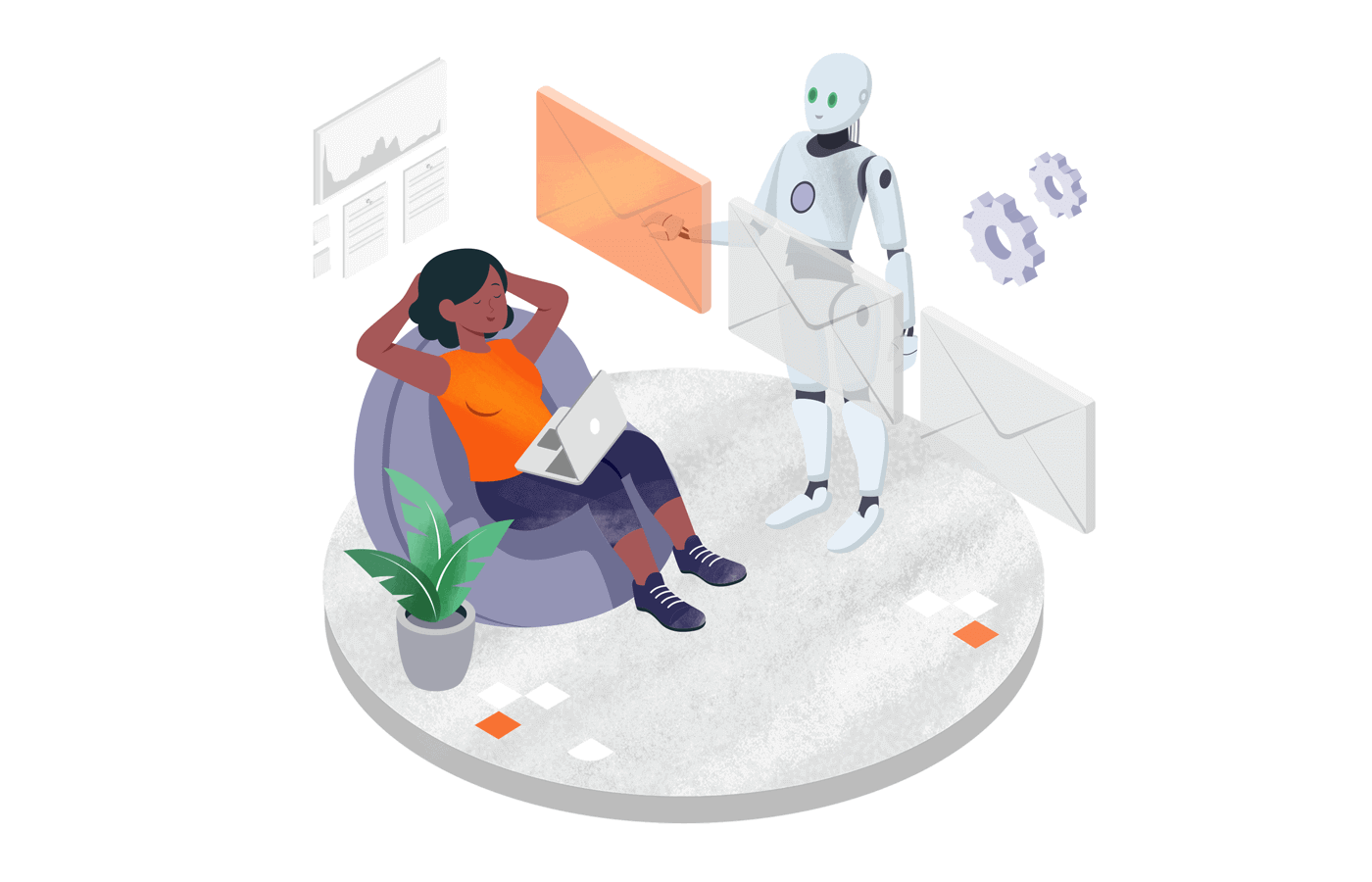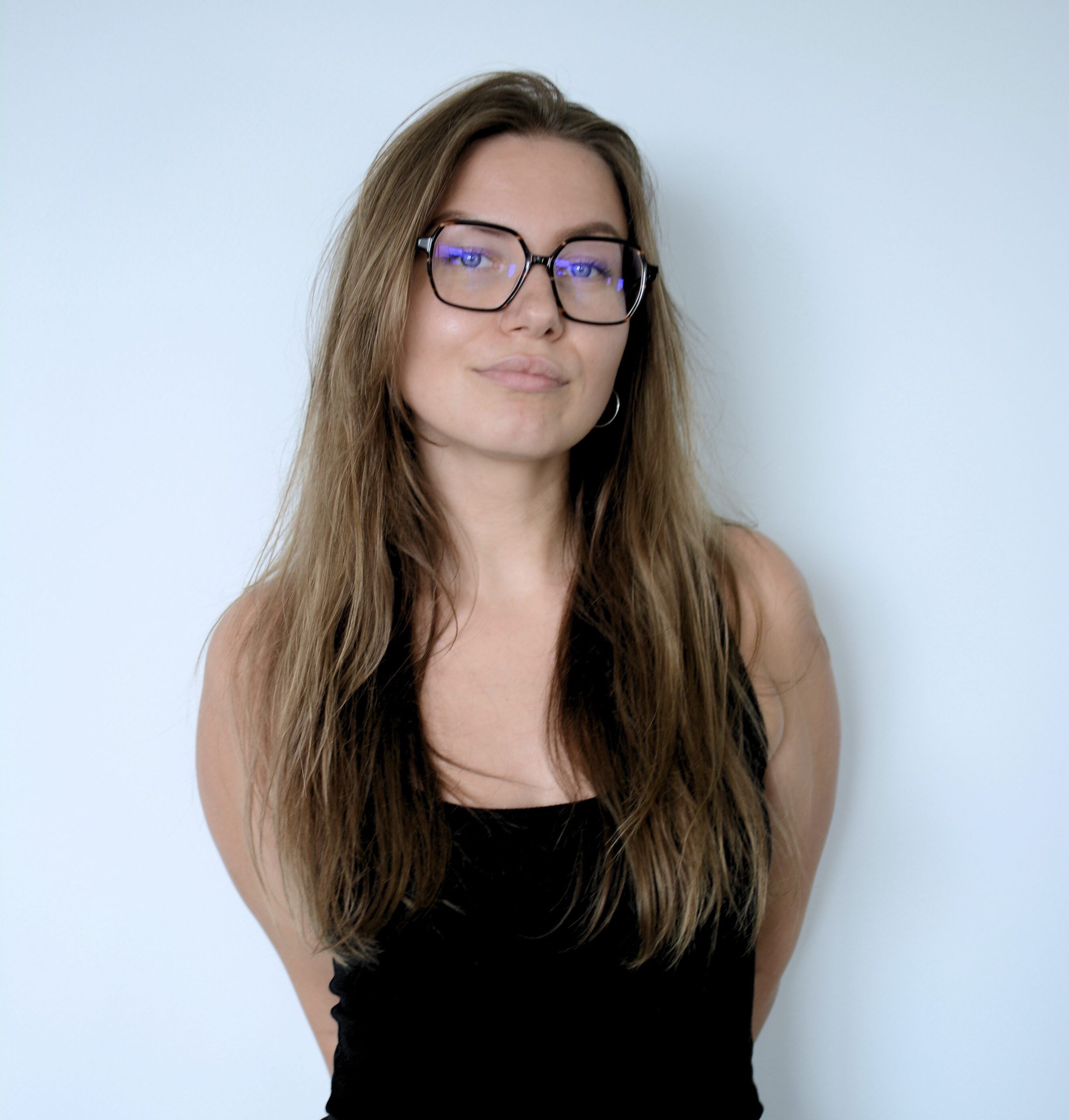Email marketing is a rewarding engagement tactic as it helps you convert visitors into leads and paying customers. It offers an ROI of $36 for every dollar spent. Plus, it also helps you build relationships with your existing customers. In fact, 41% of marketers admit that email is their most effective marketing channel.
In this blog, let’s look at how businesses use email to succeed. We’ll also share relevant email campaign examples and tips to help you get started. Let’s dive in!
What is an Email Marketing Campaign?
An email marketing campaign is a well-coordinated effort where marketing emails are sent out in a series of related emails. The main goal of these campaigns is to get recipients interested, whether that means buying something, introducing new products, or getting those new leads.
While there are many different elements that define successful email marketing campaigns, attention-grabbing subject lines and clear calls-to-action can make a real difference. Personalization and smart timing helps boost open rates and conversions, too.
18 Best Email Marketing Campaign Examples
Successful email marketing campaigns are a great way to build trust and nurture long-term relationships with your target audience. Email marketing emails can also be powerful channels for building a loyal customer base.
If you’re wondering what successful (and beautiful) campaigns look like, check the best emailer examples we’ve compiled. Your inspiration for the best email marketing templates might be among them!
- Seasonal promotions — Sender
- Welcome email — Food52
- Promotional emails —Headspace
- Newsletter emails — Goodreads
- New arrivals email — Forever 21
- Product launch email —Clay
- New article emails — DocuSign
- Feedback email — National Express
- Follow-up email – Revue
- Onboarding email – Grammarly
- Nurturing email — Framebridge
- Event reminder email — General Assembly
- Re-engagement email — Animoto
- Abandoned cart email — ASOS
- Product promotion email — Fast Times Skateboarding
- Thank you email — Austrian Airlines
- Personalized email — Trustpilot
- Order confirmation emails — AirBnB
1. Seasonal Promotions — Sender
Seasonal email marketing campaigns help brands tap into the excitement and positive vibes of holidays and seasonal shifts. Whether it’s Valentine’s Day, Halloween, or that time when winter starts giving way to spring, these moments offer great opportunities to boost sales and increase engagement. The best part? There’s a seasonal angle to take advantage of all year round!
While it takes some planning and might feel a bit overwhelming at first, it can lead to impressive results. For example, a survey found that 68% of shoppers pay more attention to brand emails during the holidays — with certain occasions (looking at you, Black Friday) boosting website visits by up to 20%.
By using this email template, you’ll be able to craft a marketing campaign that’s perfectly tailored to the holiday or seasonal event you’re aiming for, matching the mood and expectations of your target audience.
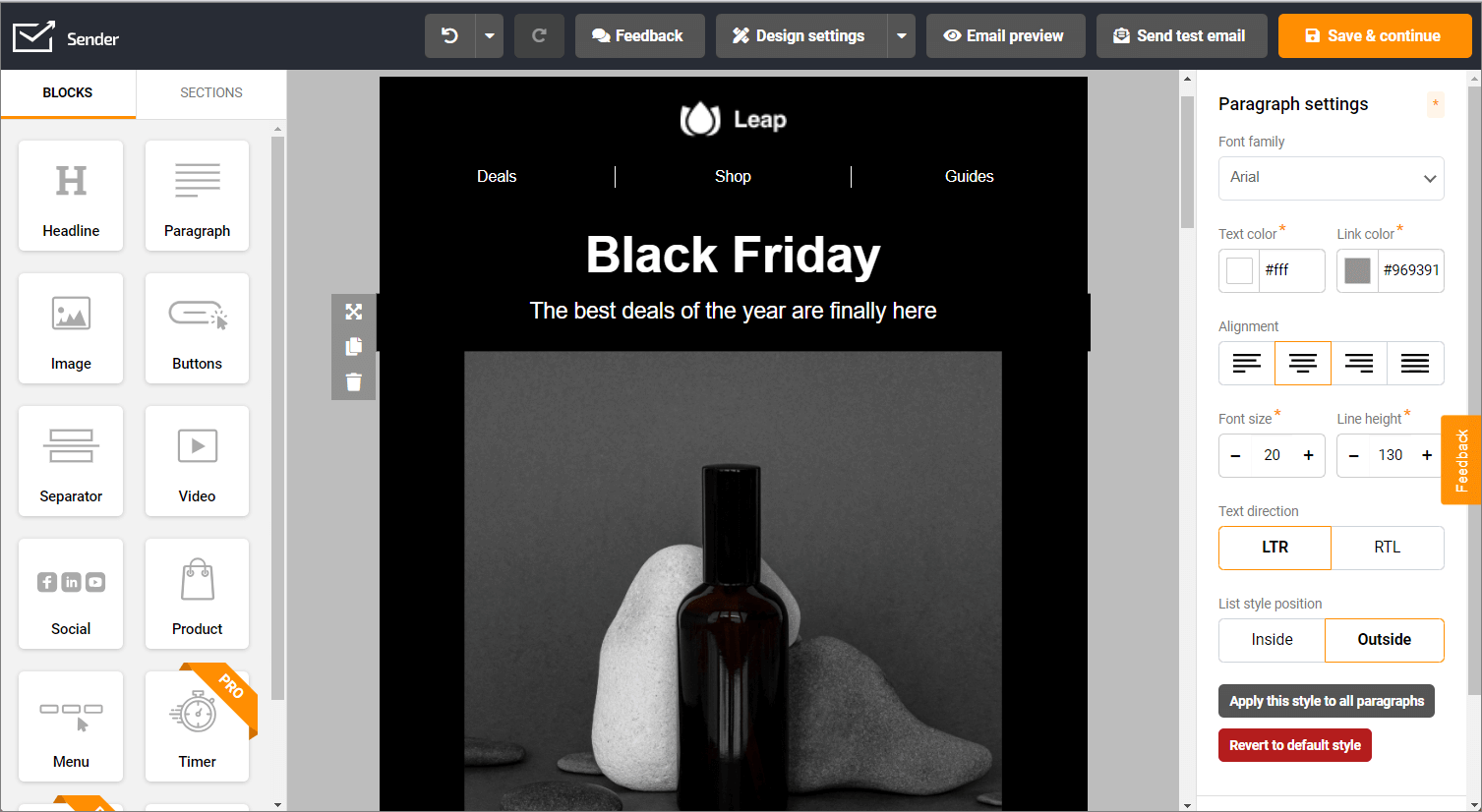
Type: Seasonal email template
What makes it great?
- The heartfelt message resonates with recipients by tapping into the emotional significance of Mother’s Day;
- The seasonal context creates a timely reason not to pass on such an offer, further boosting engagement with highly relevant content;
- Including a highlighted discount code adds value and encourages conversions without feeling overly salesy;
- It strengthens brand-consumer relationships by blending promotional content with appreciation, making subscribers feel valued.
What Makes ‘Seasonal Email Campaigns’ Effective
Seasonal email campaigns are opportunities not to be missed because they align with plenty of holidays and events spread throughout the year. Each one presents a unique opportunity for businesses to meet customer spending habits and increase engagement.
For instance, when the spooky season comes, it’s the perfect time for e-commerce and brick-and-mortar brands to promote Halloween costumes and season-themed décor. Of course, not every seasonal event will suit your brand like a piece of puzzle, but a well-timed discount paired with a cheeky animated GIF can go a long way in encouraging conversions.
Starting With ‘Seasonal’ Campaign
Planning your first seasonal marketing campaign can be overwhelming, especially with a truckload of variables and holidays to choose from. The good news? You don’t need to be a seasoned marketer to get the desired results.
Follow these expert tips to kick off your seasonal campaign planning with confidence:
- Plan your holiday email campaigns at least two months in advance to ensure the best results — marketing managers who set clear, achievable goals are 376% more likely to succeed;
- Consider running test campaigns (like “Christmas in July”) to find out which products and text-visual combinations have the greatest selling potential before the actual holiday season starts knocking;
- Perform A/B testing on subject lines and content to identify potential issues before launching the campaign;
- Make sure your seasonal email campaign is mobile-optimized — it may sound like a no-brainer, but 85% of users check their emails on their phones.
2. Welcome Email — Food52
Fun fact: 74.4% of consumers expect a welcome email.
You wouldn’t want to miss such a chance to engage subscribers, would you?
Welcome emails are one of the oldest marketing tactics, but they perform exceptionally well. Welcome email examples show your appreciation for new subscribers when they sign up for your monthly or weekly newsletter. Here is a welcome email template by Food 52 that welcomes new email subscribers:

Type: Welcome email template
What makes it great?
- The email is sent immediately after the subscriber sign-ups, ensuring a positive experience from the get-go;
- The tone of the email is very warm and welcoming;
- The preview text “We brought snacks” immediately grabs attention;
- The email is written as a personal letter from the brand’s founder, which adds a personal touch.
What Makes ‘Welcome Email’ Campaigns Effective
Welcome emails hit differently because they catch people at peak excitement, like greeting someone who just walked into your favorite coffee shop. Unlike promotional emails that sometimes feel (too) salesy, most people expect welcome messages.
The magic behind a well-crafted welcome email is in timing and authenticity. With the right visuals and a warm, sincere greeting, you can turn your first direct interaction into a memorable moment — one that feels welcomed, and not just tolerated.
Starting With ‘Welcome Email’ Campaign
Here are a few tips to get you started:
- Your first welcome campaign should feel like you’re personally greeting new subscribers;
- Use email automation that fires immediately – we’re talking minutes, not hours;
- Create a 3-5 email series over the first week instead of one-and-done messages;
- Include clear next steps like profile completion or downloading resources.
3. Promotional Emails — Headspace
Promotional emails are marketing emails that inform your audience about a running promotion or offer. Send such an email to promote limited-time offers, exclusive deals, and seasonal or holiday promotions. Here’s a promotional email template example from Headspace:
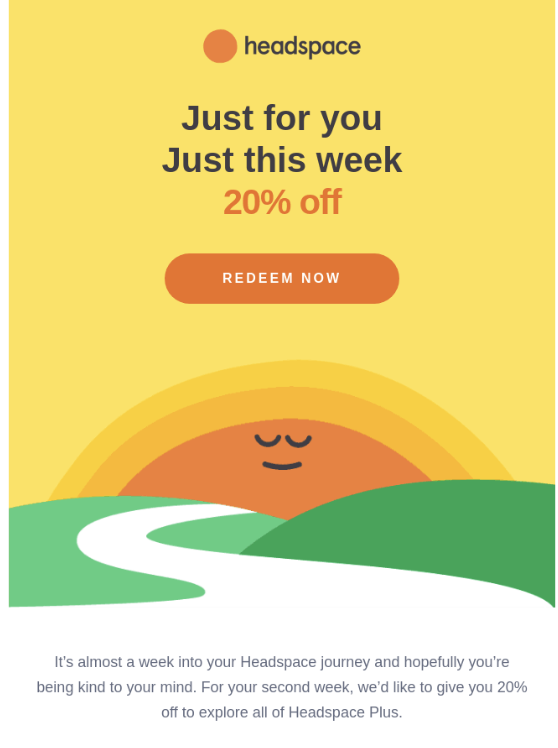
Type: Promotional email
What makes it great?
- The image reinforces the benefits of Headspace – enjoying a calm mindset;
- The whole email reflects a positive, friendly vibe, supporting the positioning of the brand’s personality;
- The layout is simple and with a single communication;
- The offer is alluring – subscribers can get an extra discount if they sign up fast;
- The element of urgency in the subject line is subtle and effective.
Pro tip: A/B test your subject lines before finalizing the best one for your email marketing campaign.
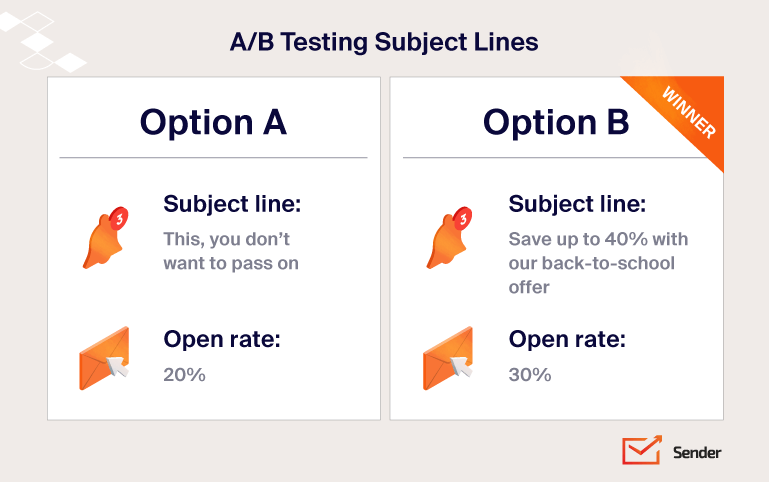
What Makes ‘Promotional Email’ Campaigns Effective
The best promotional emails work because they offer insider treatment – exclusive discounts, early access, or limited-time perks that make subscribers feel special rather than sold to. Just like a VIP pass or a discount if you’re a regular, promotional emails tap into the desire to get what subscribers want while making them feel in-the-know.
Success, like in all good things, comes down to timing and targeting. Swimwear promotions in May feel relevant. In December? Not so much. The trick is creating urgency without getting too clickbaity and pushy.
Starting With ‘Promotional Email’ Campaign
Sending your first promotional email might feel intimidating, but don’t worry – we’ve got you covered:
- Segment your audience by purchase history or interests – generic blasts usually fall flat with everyone;
- Create genuine urgency through limited quantities or time-sensitive offers, but skip the fake countdown timers;
- Include crystal-clear CTAs that tell people exactly what they’ll get.
- A/B test – try out slightly different subject lines, design elements and offers to find out which combination performs best;
4. Newsletter Emails — Goodreads
If you’re anything like us, nothing beats getting a well-crafted newsletter. While media outlets use them mostly to recap top stories of the week, commerce brands have adapted this classic email format to nurture the relationship with current customers. Instead of hard-selling, these brands deliver exclusive, high-value content that has subscribers’ interests in mind.
Writing an effective newsletter that doesn’t give readers any ideas to hover over that troubling “Unsubscribe” button is a form of art. Check out this simple yet engaging email campaign from Goodreads for inspiration:
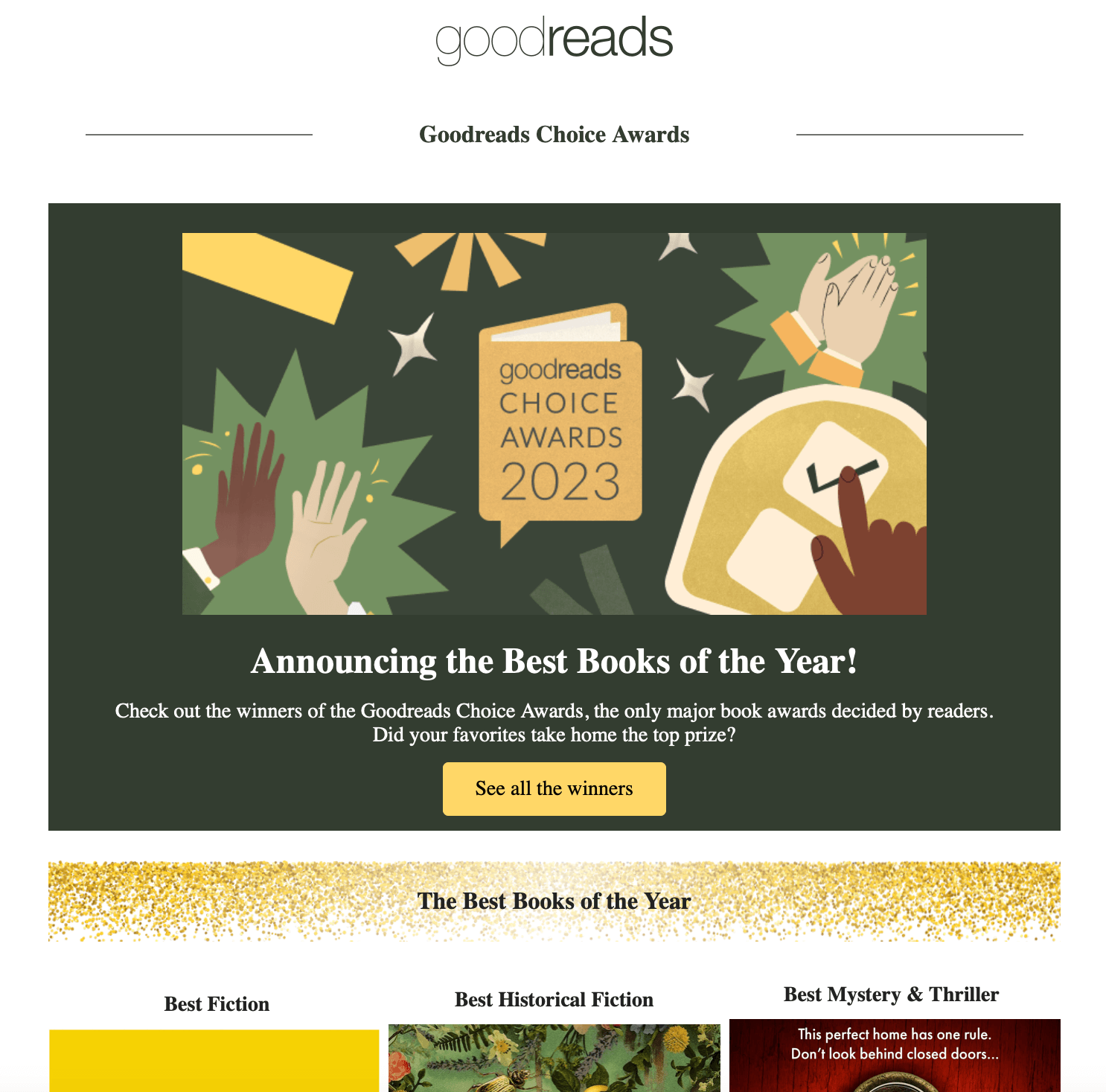
Type: Informative newsletter campaign
What makes it great?
- It maintains brand consistency while keeping its audience in mind;
- Its visual and no-fluff newsletter takes less than a few seconds to finish, before getting to its CTA (“See all the winners”);
- It taps into readers’ curiosity to see if their favorites made the curated list, or even claimed the “Best Book of the Year” title.
What Makes ‘Newsletter Email’ Campaigns Effective
Think of newsletter campaigns like hosting a chat with your current subscribers over a cup of joe. Newsletters work because they nurture relationships instead of just pushing sales.
Similarly to regular blog posts, what makes them stick is consistency and value. People subscribe to newsletters because they want to stay informed, entertained, or even inspired every week.
Starting With ‘Newsletter Email’ Campaign
Some say that starting your first newsletter campaign can feel a bit like staring at a blank page and being dumbfounded by endless possibilities. Well, here are a couple of starting tips that should get you going:
- Pick a consistent schedule and stick to it – whether weekly, bi-weekly, or monthly, reliability builds trust and expectation;
- Focus on one main theme per issue rather than cramming everything in – think focused conversation, not information dump;
- Mix educational content with personality – share industry insights alongside company updates or team spotlights;
- Keep your design clean and scannable with short paragraphs, clear headers, and plenty of white space for easy mobile reading.
5. New Arrivals Email — Forever 21
Effective email campaigns entice customers to act. And what’s a better incentive to act fast than announcing a new collection? Sending a new arrivals email is a great tactic to engage if your audience is fast-moving and trend-conscious.
Use contextual CTAs linking to the product pages to close sales in such emails to make them more effective. Here’s an effective marketing campaign example by Forever 21:
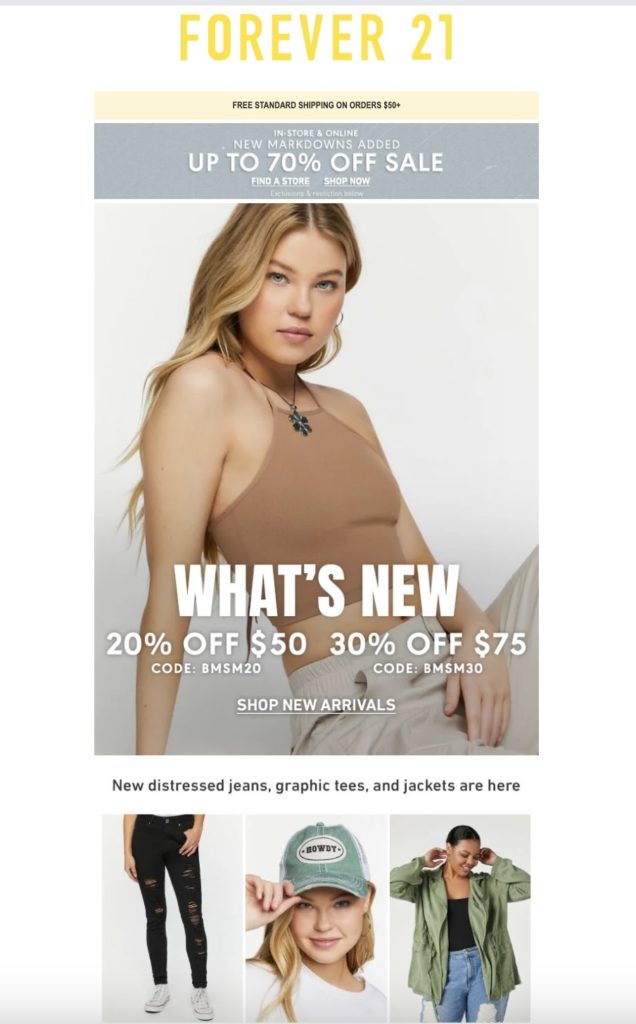
Type: Effective marketing campaign
What makes it great?
- The email has personalized recommendations for all the new things at their online store;
- It’s also highly visual, with high-quality images immediately catching your gaze;
- The limited-time discount code encourages customers to take action;
- The star ratings tell the users that though the products are new, they are equally loved by shoppers with similar tastes.
What Makes ‘New Arrivals Email’ Campaigns Effective
New arrival emails tap into something primal: a combination of FOMO and the excitement of discovery. They work because they make subscribers feel like insiders getting first dibs on the latest and greatest.
The psychology of new arrivals email campaigns is that people don’t just want new products — they want to be among the first to have them. These campaigns create urgency without being pushy. Plus, they satisfy our natural curiosity about what’s next.
Starting With ‘New Arrivals Email’ Campaign
Here are some proven strategies, helpful tips, and expert suggestions to help you craft irresistible new arrivals emails:
- Time your sends strategically – hit inboxes when your audience is most likely to shop, typically mid-week mornings;
- Lead with your strongest product – put your best new item front and center with high-quality images;
- Create a sense of discovery with subject lines like “Just dropped” or “Fresh arrivals” rather than generic “New products”;
- Lead them with a clear CTA – whether it’s “Shop Now” or “Discover More”, your CTA should be attention-grabbing and easy to spot.
6. Product Launch Email — Clay
Share about the latest updates, upcoming promotions, media features, or any other information via an announcement email. You can also plan an announcement email marketing campaign to share updates about new feature development, release a new app, or simply announce a fresh sale.
Look at this successful email campaign example from Clay:
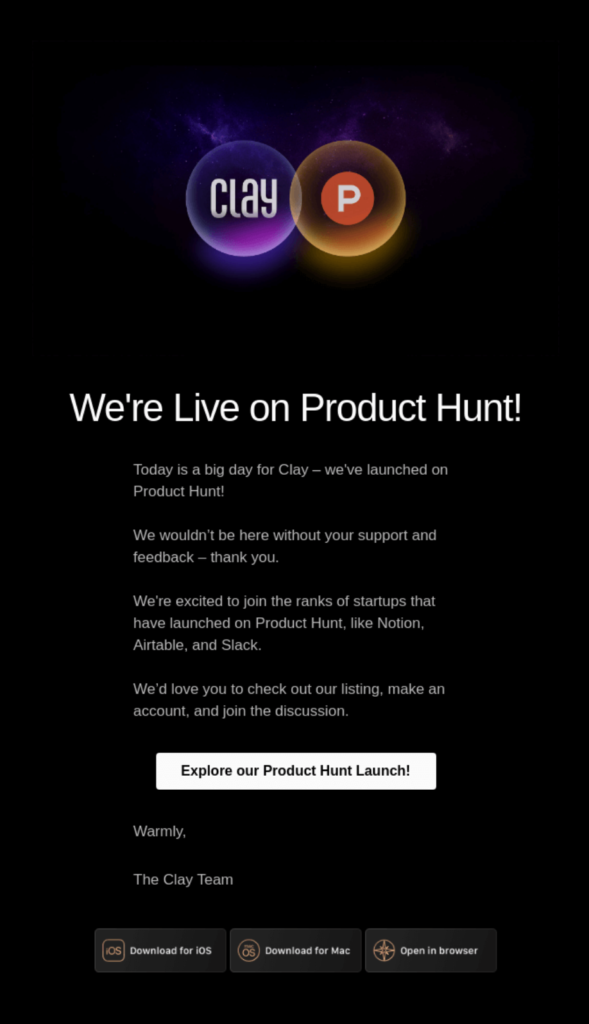
Type: Company announcement email template
What makes it great?
- This marketing email sample shares about its product launch in an engaging way;
- It urges subscribers to support them by checking out their Product Hunt listing;
- The simple email copy with a big, clear CTA button clearly states the intention of the email with just a glance.
What Makes ‘Product Launch Email’ Campaigns Effective
Product launch emails work because they tap into our natural excitement about new things and exclusive access. They transform a simple product announcement into an event that subscribers want to be part of.
The key is building anticipation without overselling it. People want to feel excited about what’s coming, not overwhelmed by marketing speak.
Starting With ‘Product Launch Email’ Campaign
Planning your first product launch email feels like preparing for a big presentation. Here are some tips to help you out:
- Tease before you reveal – send a “something’s coming” email a week before the full announcement to build curiosity;
- Lead with the problem you’re solving rather than technical specs – people buy solutions, not features;
- Include early customer testimonials or a promotional blurb from critics and influencers to add credibility;
- Create clear next steps with prominent buttons like “Be the first to try it” or “Get early access”.
7. New Article Emails — DocuSign
New article emails inform subscribers about your website’s latest blog or article. Such emails are used to generate traffic and boost online engagement. Such emails are automatically sent every time you publish a new blog post. Look at this email marketing example by DocuSign:
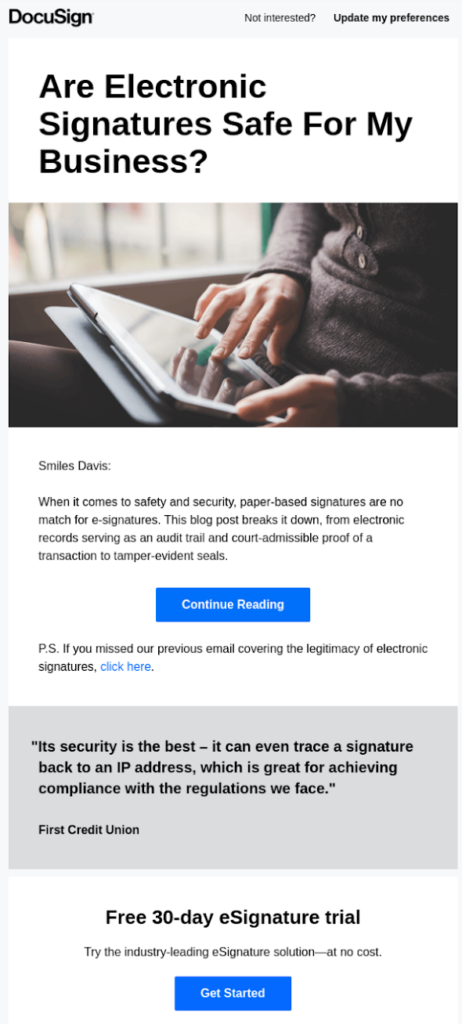
Type: New article email template
What makes it great?
- The curated content highlights the latest blog post and what it means for them as a reader;
- It has a bold header announcing the new post’s topic and a clear CTA;
- The post-script message also makes the reader curious about the previous post.
What Makes ‘New Article’ Email Campaigns Effective
‘New article’ email campaigns are your brand’s way of saying, “Hey, we’ve written something we think you’ll want to read.” They work because they position you as a helpful resource rather than just another company trying to push another sale.
The magic happens when your content actually helps people solve problems or learn something new.
Starting With ‘New Article’ Campaign
Sending your first new article email can feel a bit intimidating, but the heavy lifting has already been done by the article’s author. Follow these tips to ensure it hits the mark:
- Write compelling subject lines that highlight the benefit, not just the topic – “How to cut meeting time in half” beats “New productivity article”;
- Include a short preview in the email itself to give people a taste of what they’ll get;
- Time your sends strategically – educational content performs well on Tuesday-Thursday mornings when people are in “learning mode”;
- Track which topics resonate with your audience so you can create more content they actually want.
8. Feedback Email — National Express
Feedback emails are a time-tested way to turn first-time buyers into loyal customers. Not only do they help you better understand customer satisfaction, but they’re also a great chance to throw in a discount in exchange for their time — which often leads to repeat use of the services. Now that’s what we call a win-win.
Take a look at this simple yet effective feedback email example by National Express:
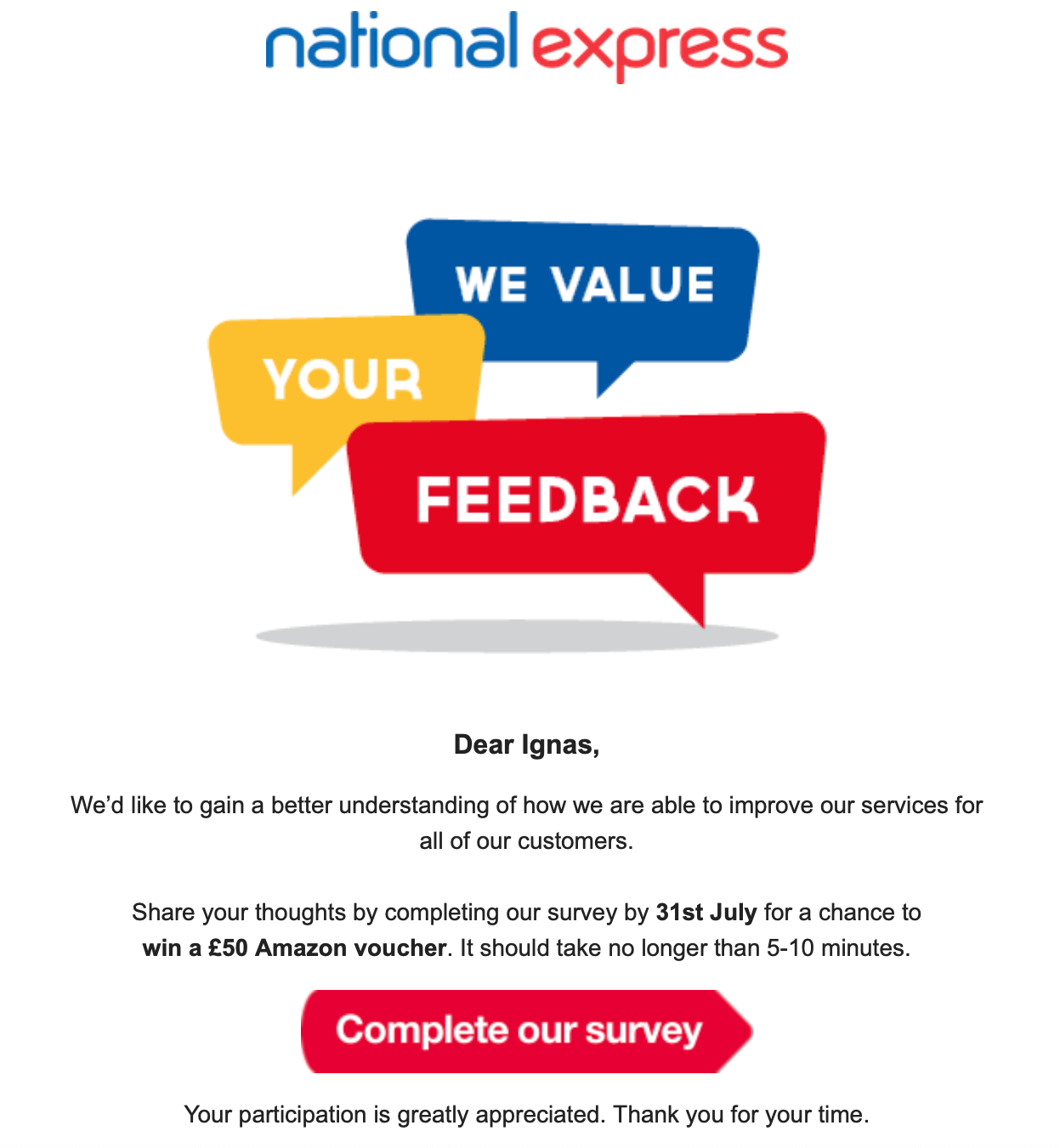
Type: Feedback email template
What makes it great?
- This feedback email uses a clear, eye-catching CTA (“Complete our survey”);
- It uses an Amazon voucher as an incentive to reward you for taking the time;
- It respects your time by setting honest expectations (“no longer than 5-10 minutes”).
What Makes ‘Feedback Email’ Campaigns Effective
Feedback emails campaigns work because, instead of talking at customers, you’re asking them to talk back. People appreciate it when brands want to hear their thoughts, especially when you can offer them something in return.
The timing is everything, though. Catching someone within days of a purchase or conversion means their experience is still fresh and they’re more likely to share honest insights.
Starting With ‘Feedback Email’ Campaign
Creating your first feedback email feels overwhelming, but here’s how to nail it:
- Send within 3-7 days after purchase or interaction while the experience is still clear in their memory;
- Keep surveys short – aim for 3-5 questions max, or you’ll lose people halfway through;
- Offer a small incentive like a discount code or entry into a drawing to boost response rates;
- Ask specific questions about their experience rather than vague “How did we do?” prompts.
9. Follow-up Emails — Revue
Follow-up emails help engage and nurture your leads throughout the buying process. These targeted campaigns offer context, add value, and typically feature a call to action, such as requesting a callback or completing a survey. Here’s an example of a follow-up email template by Revue:
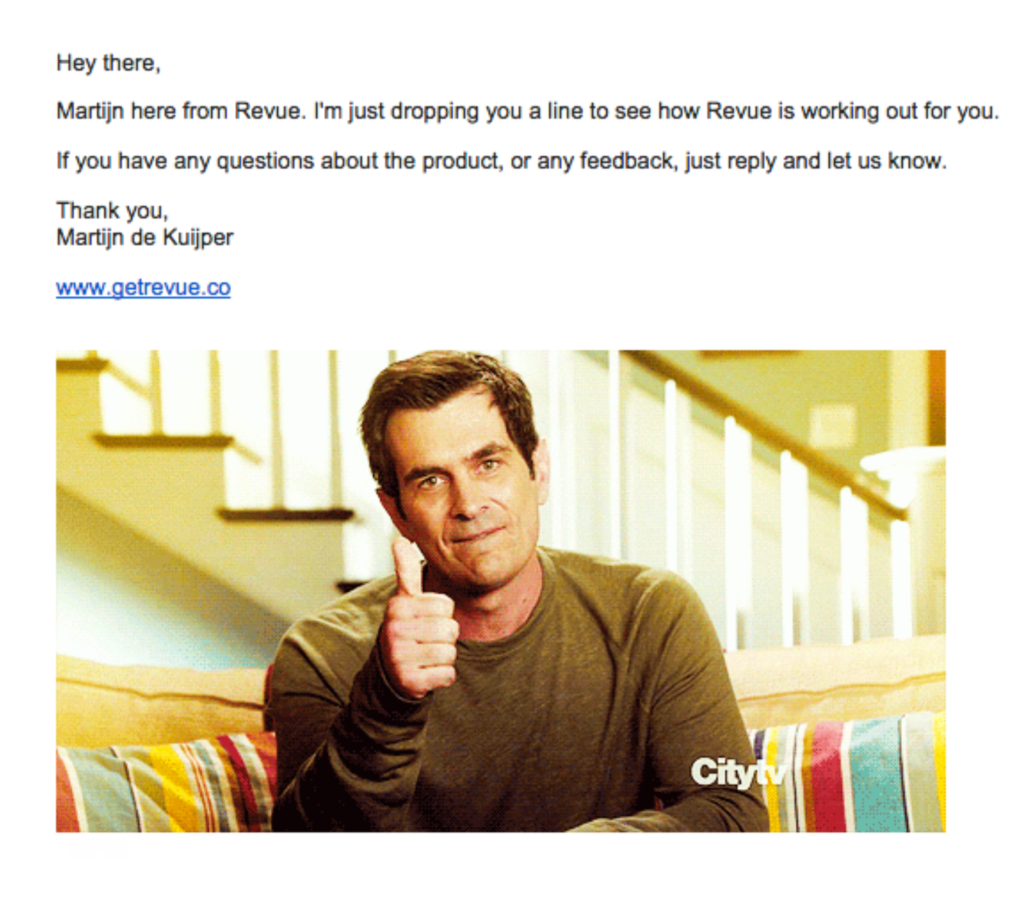
Type: Follow-up email template
What makes it great?
- This follow-up email is automatically sent 2 days after the purchase, making it timely and engaging;
- The email has a clear layout and conversational tone what makes it look like a personalized effort;
- The contextual image adds another level of engagement to their follow-up game.
What Makes ‘Follow-up Email’ Campaigns Effective
Follow-up email campaigns work because they catch people at the perfect moment – right after they’ve taken an action but before they’ve moved on to something else.
Whether someone just made a purchase, downloaded a resource, or attended your webinar, they’re still thinking about you and your brand. The secret is providing value rather than just checking a box.
Starting With ‘Follow-up Email’ Campaign
Writing your first follow-up email can feel tricky, but here’s how you can get it right:
- Send follow-up emails within 24-48 hours while the original interaction is still fresh in people’s minds;
- Reference their specific action to create continuity – “Thanks for downloading our guide” beats generic “Thanks for your interest”;
- Provide immediate next steps or additional resources that build on what they just did;
- Keep the tone conversational and helpful rather than desperate and salesy.
10. Onboarding Email — Grammarly
When a visitor signs up, joins a community, or buys something for the first time, a getting started’ or onboarding email is sent. Such emails increase user delight by providing helpful information for onboarding successfully.
You can use an onboarding email to educate users, introduce them to new features, get them to complete the signup process, or provide additional offers. Here’s an onboarding email campaign example by Grammarly:

Type: Getting started email template
What makes it great?
- The email does a great job of sharing the following steps and making them aware of how to use Grammarly;
- They’ve added an option to contact at the end of the email to reassure subscribers that they’re open to feedback;
- The new subscribers are also informed they can trust to get support whenever needed.
What Makes ‘Onboarding Email’ Campaigns Effective
Onboarding emails work because they catch people at their most motivated moment – right after they’ve decided to try something new. Whether a lead just signed up for your software, courses, or joined your service, they’re excited to get started and figure things out.
The magic happens when you guide that initial enthusiasm into actual success. Instead of leaving new customers to wander around confused, good onboarding campaigns provide a clear roadmap and sprinkle the journey with educational emails, which leads to nurtured relationships.
Starting With ‘Onboarding Email’ Campaign
Your first onboarding sequence needs to be strategic, not overwhelming. Here’s how you can nail it:
- Map out critical success milestones – identify the 3-5 key actions that lead to “aha moments” for new users;
- Space emails strategically – send them over 7-14 days rather than flooding people’s inboxes all at once;
- Focus on one action per email – don’t try to teach everything in one message or people will get paralyzed;
- Plan out an onboarding campaign checklist – this helps to stay organized and ensures that every customer receives consistent, high-quality attention.
11. Nurturing Email — Framebridge
Nurturing subscribers with email drip campaign examples isn’t all about sharing promotional content. It also involves adding value and helping your potential customers.
They’ll trust you more if you nurture leads by appearing helpful. Look at one of the better examples of a nurturing email template by Framebridge:
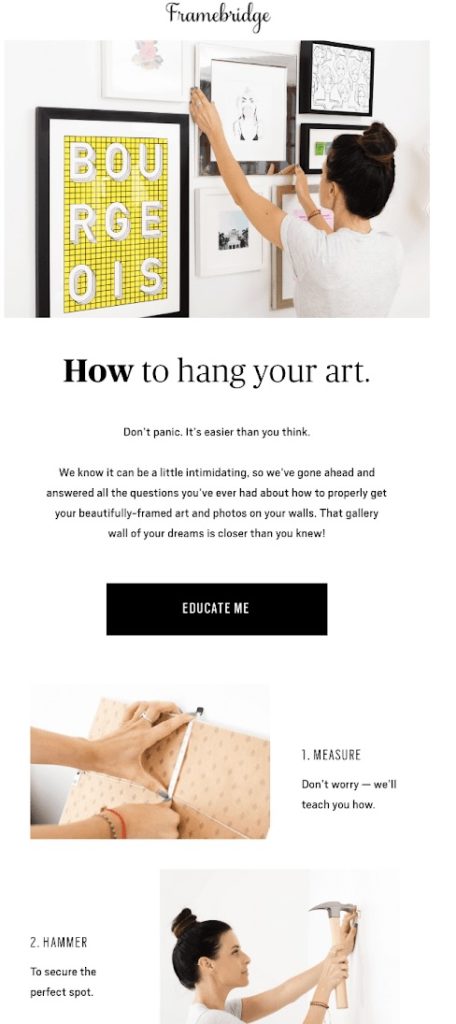
Type: Nurturing email template
What makes it great?
- The email is funny and also shares valuable information with the subscriber, improving the brand recall;
- Using email as a tutorial to hang frames is a nice trick to make subscribers remember to order frames for their walls;
- The CTA is placed strategically to attract clicks to their store.
What Makes ‘Email Nurturing’ Campaigns Effective
Nurturing email campaigns are a cornerstone of any successful email marketing strategy. Their power lies in turning potential leads into conversions through a mix of education and audience segmentation.
What sets effective nurturing email campaigns apart is personalization. By leveraging current customers’ behavior, like sign-ups or browsing history, marketers can deliver relevant content that speaks directly to subscribers’ interests. In fact, 67% of email marketers are investing more in highly personalized campaigns for this very reason.
Starting With ‘Email Nurturing’ Campaign
Building your first nurturing sequence requires patience and strategy. Here’s how to get it right:
- Map your customer journey stages – identify where people get stuck and create content that helps them move forward
- Focus on education over promotion – share tips, insights, and resources that solve real problems your audience faces;
- Space emails thoughtfully – send them weekly or bi-weekly to stay present without overwhelming people’s inboxes;
- Track engagement patterns – monitor which content types get the best response and double down on what works.
12. Event Reminder Email — General Assembly
Many people sign up for offline or online events, yet only a fraction attend them. To help forgetful people, send event reminders by email. This will increase the turn-around ratio and push potential leads further into the buyer’s journey. Here’s a great event reminder template from the Email Design Workshop:

Type: Event reminder template
What makes it great?
- The email design is eye-catching and straightforward;
- Such newsletter design is also very mobile-friendly;
- It uses a clear layout with a self-explanatory header image and webinar details;
- The support email mentioned at the end encourages the reader to contact in case of confusion, increasing trust.
What Makes ‘Event Reminder Email’ Campaigns Effective
Event reminder emails work because they solve a universal human problem: we all forget things, especially when life gets busy. People want to attend events they’ve registered for, but between work deadlines and daily chaos, that webinar or workshop can easily slip their minds.
When it comes to event reminder emails, the timing is everything. Send them too early and people forget again; too late and they’ve already made other plans. Great event reminders feel helpful rather than pushy – they’re serving the recipient’s interests, not just trying to boost attendance numbers.
Starting With ‘Email Event Reminder’ Campaign
Your first event reminder sequence should feel like a helpful friend keeping you on track. Here’s how to get it right:
- Send multiple reminders strategically – typically one week before, one day before, and a few hours before the event starts;
- Include all essential details – date, time, timezone, location or login links, and what to bring or prepare;
- Add value beyond logistics – share what attendees can expect, preview key topics, or highlight special guests;
- Make joining effortless – include direct calendar links and one-click access to virtual event platforms.
13. Re-Engagement Email — Animoto
Send re-engagement emails, also called customer retention emails, to customers who were active before but aren’t responding to your email marketing campaign currently.
When done well, these emails reduce churn rates and increase customer engagement. Here’s a re-engagement email marketing campaign from Animoto:
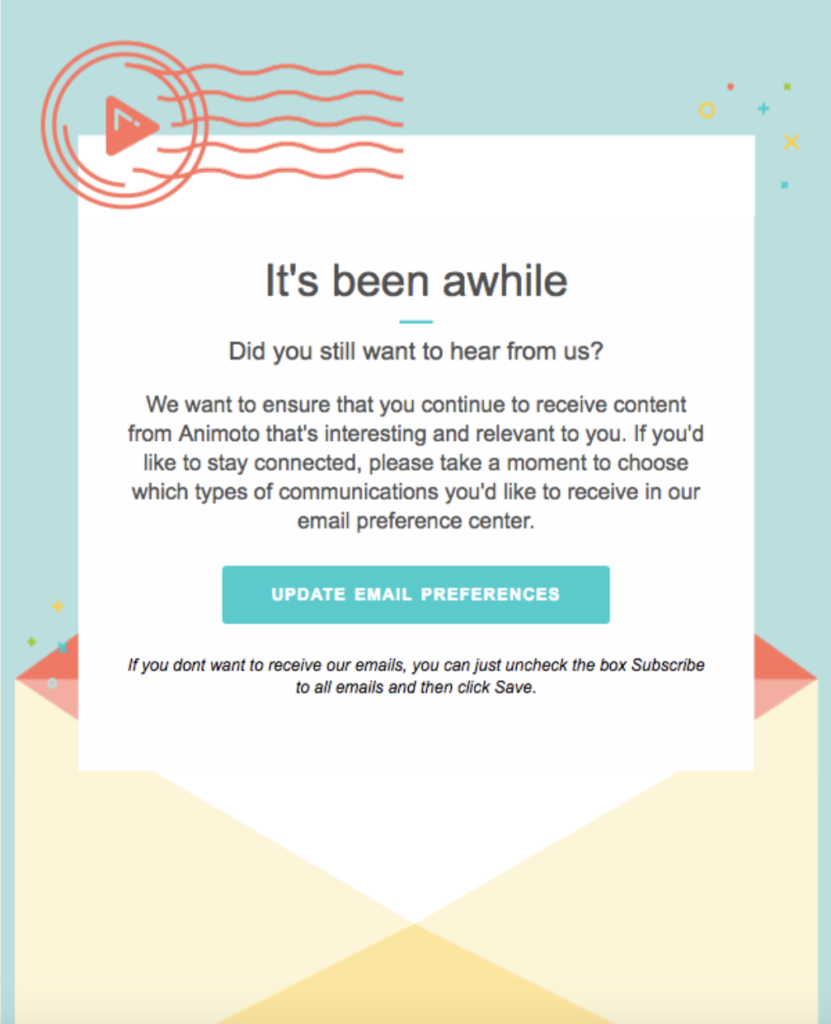
Type: Re-engagement email
What makes it great?
- To re-engage inactive subscribers, Animoto asks a straightforward question – do they want to hear from the brand?
- Their primary goal is to entice users to take an action;
- The CTA asks recipients to update their email preferences if they want to continue receiving emails (or not) by redirecting them to the preference center.
What Makes ‘Re-engagement Email’ Campaigns Effective
Re-engagement emails work because they acknowledge what everyone already knows – people have checked out, and that’s okay. Instead of pretending everything’s fine, these campaigns address the silence directly with a simple question: “Do you still want to hear from us?”
The psychology here is fascinating. When someone hasn’t engaged with your emails for months, bombarding them with more promotional content just pushes them further away. But a genuine “we miss you” message? That can spark curiosity and remind them why they signed up in the first place.
Starting With ‘Re-engagement Email’ Campaign
Your first re-engagement email campaign should feel like a genuine check-in, not a desperate plea. Here are some tips to start you off:
- Target the right inactive period – typically 3-6 months of no engagement, depending on your normal sending frequency;
- Be honest about the situation – acknowledge they haven’t been opening emails rather than pretending nothing happened;
- Offer real value as a comeback incentive – exclusive content, special discounts, or early access to new features;
- Make it easy to choose their path – clear options to update preferences, reduce frequency, or unsubscribe gracefully.
14. Abandoned Cart Email — ASOS
Customers often abandon their carts for several reasons – the website crashes, the process is complicated, or they get distracted. Abandoned cart recovery emails convert three times more than any other type of automated email marketing campaign. Here’s an example of an abandoned cart email by ASOS:
Type: Abandoned cart email template
What makes it great?
- This effective abandoned cart email campaign has a clear call-to-action (CTA);
- It says the stock is limited, so the chances of closing a sale are even higher;
- The email is designed to make the abandoned cart item preview stand out.
What Makes ‘Abandoned Cart Email’ Campaigns Effective
Abandoned cart emails work because they catch people in that peculiar moment between “I want this” and “eh, maybe later”. We’ve all been there – adding items to our cart, getting distracted by a phone call or that rabbit hole of product reviews, and then completely forgetting about our intended purchase.
These transactional emails work because they’re not trying to convince you to buy something new – they’re simply reminding you about a decision you already made.
Starting With ‘Abandoned Cart’ Emails
Your first abandoned cart sequence should feel helpful, not pushy. Here’s the approach that works:
- Time your first email strategically – send it within 1-3 hours while the shopping session is still fresh in their mind;
- Show them exactly what they left behind – include product images, names, and prices to jog their memory;
- Address common abandonment reasons – mention free shipping thresholds, return policies, or security guarantees;
- Create a sense of gentle urgency – limited stock alerts or time-sensitive discounts, but keep it authentic.
15. Product Promotion Email — Fast Times Skateboarding
Product promotion emails invite users to try out your product or service at a discount and help generate additional sales for your brand. They typically include a call-to-action (CTA) to check out more product details on the website. Here’s an example of a product promotion email:

Type: Product promotion email template
What makes it great?
- The email highlights the product and its features right from the beginning;
- The informative product image is an attention-grabbing feature of the email;
- The use of product images in real settings influences the reader to think about how the product would look;
- The CTA would compel most people to explore more details.
What Makes ‘Product Promotion Email’ Campaigns Effective
Product promotion emails work because they hit that sweet spot between “here’s something cool” and “here’s why you need it now”. Unlike general promotional emails that feel like digital billboards, good product promotions tell a story about how this specific item fits into your life or solves your problem.
The magic happens when you focus on benefits rather than features. Nobody cares that your headphones have “advanced noise-canceling technology” – they care that they can finally work in peace while their neighbor renovates their kitchen. The best product promotions make people think, “I didn’t know I needed this, but now I absolutely do.”
Starting With ‘Product Promotion Email’ Campaign
Your first product promotion email should feel like a friend telling you about something awesome they just discovered. Here are a couple of pointers on how you can achieve that effect:
- Lead with the problem it solves – start with the pain point your audience recognizes, then introduce your product as the solution;
- Use high-quality visuals – show the product in action or in realistic settings that help people visualize owning it;
- Create genuine scarcity – limited quantities or time-sensitive launches work, but avoid fake urgency that trains people to ignore you;
- Include social proof – early reviews, testimonials, or “customers who bought this also loved” recommendations build confidence in new products.
16. Thank You Email — Austrian Airlines
Your customers want to feel appreciated, and a ‘Thank You’ email is a great way to make them feel special. You can send an email thanking the customer for their purchase, engaging with your content/website, or for their loyalty.
Here’s an example of confirmation emails with a ‘Thank you’ message by Austrian Airlines:
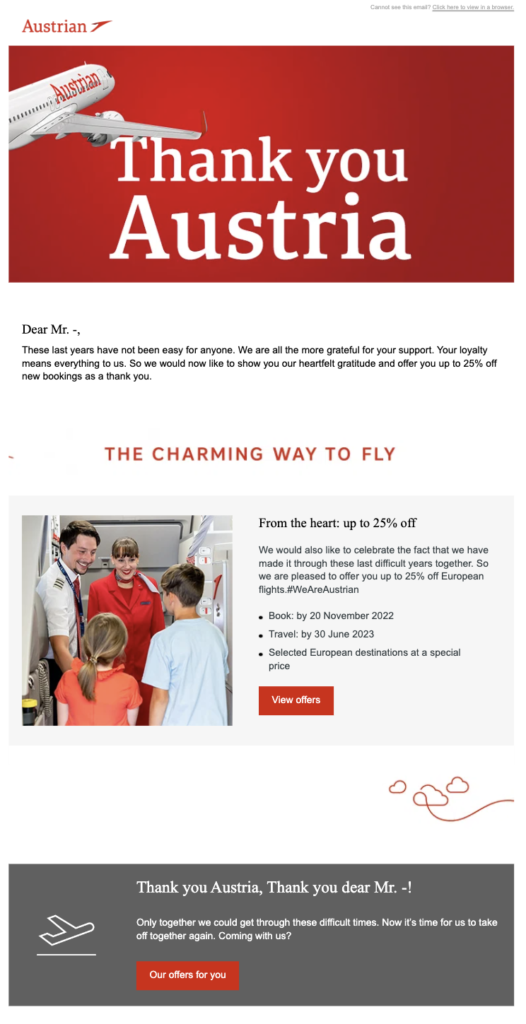
Type: ‘Thank you’ email template
What makes it great?
- This campaign thanks the flyer for their loyalty;
- It also provides a 25% discount on their next flying experience as a token of appreciation;
- The email starts with the flyer’s first name as a personalization tactic;
- Opening with a heartfelt note compels to keep reading.
What Makes ‘Thank You’ Emails Effective
Thank you emails work because they catch people in that post-purchase glow when they’re genuinely happy about their decision. It’s that brief window where buyer’s remorse hasn’t kicked in yet, and people are excited about what they just bought. Timing here is everything – strike while the satisfaction is hot.
These emails feel different because they’re not asking for anything. No hidden agenda, no sneaky upsells buried in the fine print. Just a genuine “hey, thanks for choosing us” that makes people feel good about spending their money. It’s customer service disguised as marketing, and when done right, it doesn’t feel like marketing at all.
Starting With ‘Thank You’ Emails
Your first thank-you email should feel like a warm handshake after a great transaction. Here’s how to get it right:
- Send it immediately after purchase – automate it to arrive within minutes while the buying experience is still fresh in their mind;
- Include order details and next steps – confirmation number, shipping timeline, and what to expect so people feel confident about their purchase;
- Add a personal touch – mention the specific product they bought and why it’s going to be great for them;
- Set expectations for future communication – let them know when they’ll hear from you next and what kind of emails they can expect.
17. Personalized Email — Trustpilot
If you’re still wondering what effective email marketing campaigns look like, consider personalized email campaigns. Including personalization in your email marketing strategy ensures that your customers receive tailored messages that resonate with their interests and preferences.
There are many ways to add a touch of personalization to your communication based on your audience’s preferences, behavior, demographics, and more. Here’s one of the personalized email marketing examples you won’t see every day:

Type: Personalized email
What makes it great?
- Trustpilot personalizes its emails based not on customer behavior but on its impact;
- Showing how many views and clicks the review garnered engages the user and motivates them to leave even more reviews;
- The email is also personalized with the recipient’s name.
What Makes ‘Personalized Email’ Campaigns Effective
Personalized emails work because they make people feel seen rather than just marketed. Think happy birthday emails, references to recent purchases, or product suggestions based on your browsing history. This creates this little moment of “oh, they actually pay attention.”
The trick is walking the line between helpful and creepy. Good personalization feels like a thoughtful recommendation from someone who knows your preferences. Bad personalization feels like you’re being watched through your screen.
The difference usually comes down to using data to add value rather than just showing off that you have it.
Starting With ‘Personalized Email’ Campaign
Your first campaign doesn’t need to be super highly personalized – start simple and build from there:
- Begin with basic segmentation – divide your list by purchase history, location, or signup source rather than trying to create dozens of micro-segments;
- Use dynamic content blocks – swap out product recommendations, images, or offers based on customer data without creating entirely separate emails;
- Test one variable at a time – try personalized subject lines first, then move to content personalization once you see what resonates;
- Focus on relevance over cleverness – showing someone winter coats when they live in Florida isn’t personalized, it’s just bad targeting.
18. Order Confirmation Email – AirBnB
Order confirmation emails are the bread and butter of email marketing. Confirmation emails have one of the highest open rates because they confirm that an online purchase or a booking was made, reassuring customers that everything is going smoothly.
When it comes to order confirmation emails, Airbnb has one of the best email marketing examples:
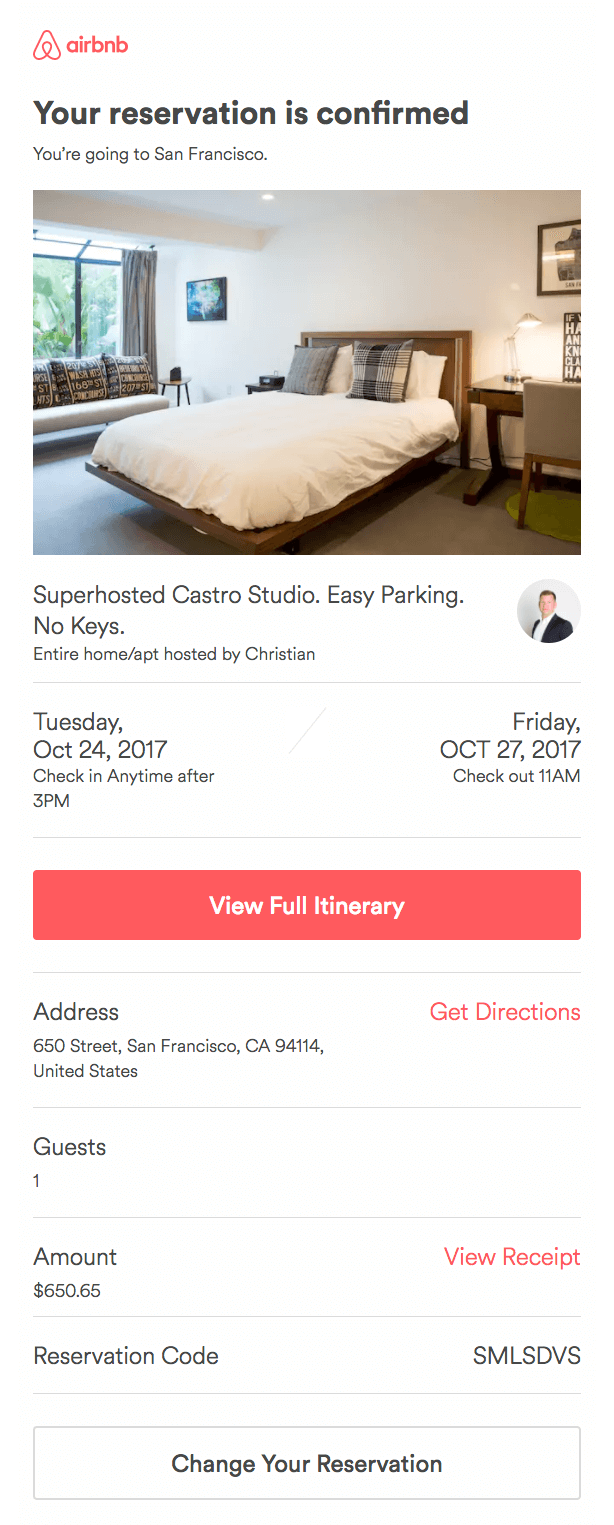
Type: Order confirmation email
What makes it great?
- The first thing that meets the eye is the photo of the place you ordered and much anticipated words (“Your reservation is confirmed”) that allow you to relax;
- It packs all the most important information (e.g., check-in and check-out dates, host’s info) about your stay in just a few lines;
- It features a clear, can’t-miss CTA (“View your full itinerary”) that people can use for cancellation or to adjust the details of their order.
What Makes ‘Order Confirmation Email Campaigns’ Effective
Order confirmation emails are the email marketing equivalent of a receipt that makes you feel good about spending money. They work because they hit people at the exact moment when they need reassurance that yes, their money went to the right place, and no, they didn’t just get scammed by some sketchy website.
These emails have a captive audience in the truest sense – people are actively looking for them. You just handed over your credit card info to the internet, so you’re definitely checking your email to make sure everything went through smoothly.
Starting With ‘Order Confirmation’ Campaign
Your first order confirmation email should be like that friend who’s good at organizing trips – all the important info, clearly laid out, with zero stress:
- Lead with the good news – “Your order is confirmed!” should be the first thing people see, not buried under a wall of legal text;
- Include all the essential details – order number, items purchased, shipping address, and timeline in a scannable format;
- Add helpful next steps – tracking info, customer service contact, or what to expect in terms of shipping updates;
- Keep the design clean and mobile-friendly – people are checking this on their phones while walking out of coffee shops, so make it easy to read quickly.
Conclusion
Email marketing might seem like a tough nut to crack at first. But with the right approach — and a few proven email marketing examples to guide you — it only takes some practice and fine-tuning before you start seeing real results.
When you have email automation tools like Sender at your disposal, you can adjust campaigns according to your budget and goals. Not only does this lead to better ROI, eventually it also leads to happier subscribers.

